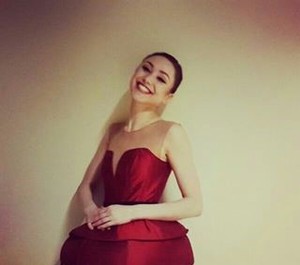| Anna LavrinenkoDancerBorn in Bagration (Kaliningrad Region).
Graduated from the Vaganova Academy of Russian Ballet in 2005.
Joined the Mariinsky Ballet in 2005.
Repertoire includes:
La Sylphide (Nancy, Sylphs); choreography by August Bournonville, revised version by Elsa-Marianne von Rosen,
La Bayadère (D’Jampe, Bayadères); choreography by Marius Petipa, revised version by Vladimir Ponomarev and Vakhtang Chabukiani,
The Sleeping Beauty (Canary Fairy, Little Red Riding Hood, Silver Fairy, Gold Fairy); choreography by Marius Petipa, revival of the 1890 production,
The Sleeping Beauty (Frolicsome Fairy, Sapphire Fairy); choreography by Marius Petipa, revised version by Konstantin Sergeyev,
Swan Lake (Cygnets, Neapolitan Dance); choreography by Marius Petipa and Lev Ivanov, revised version by Konstantin Sergeyev,
Raymonda (Grand pas); choreography by Marius Petipa, revised version by Konstantin Sergeyev,
Don Quixote (Flower-Sellers); choreography by Alexander Gorsky after motifs of Marius Petipa’s production,
Michel Fokine’s ballets Le Carnaval (Columbine) and Chopiniana (Nocturne, Eleventh Waltz),
The Fountain of Bakhchisarai (Bell Dance); choreography by Rostislav Zakharov,
The Nutcracker (Franz); choreography by Vasily Vainonen,
The Legend of Love (Shyrin’s Friends); choreography by Yuri Grigorovich,
George Balanchine’s ballets Symphony in C (I. Allegro vivo), The Four Temperaments (Theme), Theme and Variations andScotch Symphony,
Carmen-Suite (Tobacco-Workers); choreography by Alberto Alonso,
Pas de Quatre (Lucile Grahn); choreography by Anton Dolin after motifs of Jules Perrot,
Sylvia (Concubine); choreography by Frederick Ashton,
Ondine (Two Friends in Pink); choreography by Pierre Lacotte,
Le Bourgeois Gentilhomme (Lucile); choreography by Nikita Dmitrievsky,
The Golden Age (Lovers); choreography by Noah D. Gelber,
Donvena Pandoursky’s ballets Metaphysics (Coloured Drop), The Meek One (the Meek One’s Double) and Le Sacre du printemps (Dragonfly),
The Magic Nut (Beer Rat); production by Mihail Chemiakin, choreography by Donvena Pandoursky,
Le Parc; choreography by Angelin Preljocaj,
William Forsythe’s ballets In the Middle, Somewhat Elevated and Approximate Sonata,
Concerto DSCH; choreography by Alexei Ratmansky,
Sacre; choreography by Sasha Waltz,
Choreographic Game 3x3; choreography by Anton Pimonov,
Infra; choreography by Wayne McGregor,
Ballet No 2; choreography by Maxim Petrov,
and dances in the opera Ruslan and Lyudmila (Dances of Naina’s Charms, Chernomor’s Slaves).
Repertoire also includes:
Yuri Smekalov's ballets Intensio (Oil) and Camera obscura (Anneliza),
The Ring; choreography by Alexei Miroshnichenko,
Pas d’action from the ballet Laurencia; choreography by Vakhtang Chabukiani,
Ilya Zhivoi's ballets Adulte and Connections,
Inside the Lines; choreography by Anton Pimonov. Born in Bagration (Kaliningrad Region).
Graduated from the Vaganova Academy of Russian Ballet in 2005.
Joined the Mariinsky Ballet in 2005.
Repertoire includes:
La Sylphide (Nancy, Sylphs); choreography by August Bournonville, revised version by Elsa-Marianne von Rosen,
La Bayadère (D’Jampe, Bayadères); choreography by Marius Petipa, revised version by Vladimir Ponomarev and Vakhtang Chabukiani,
The Sleeping Beauty (Canary Fairy, Little Red Riding Hood, Silver Fairy, Gold Fairy); choreography by Marius Petipa, revival of the 1890 production,
The Sleeping Beauty (Frolicsome Fairy, Sapphire Fairy); choreography by Marius Petipa, revised version by Konstantin Sergeyev,
Swan Lake (Cygnets, Neapolitan Dance); choreography by Marius Petipa and Lev Ivanov, revised version by Konstantin Sergeyev,
Raymonda (Grand pas); choreography by Marius Petipa, revised version by Konstantin Sergeyev,
Don Quixote (Flower-Sellers); choreography by Alexander Gorsky after motifs of Marius Petipa’s production,
Michel Fokine’s ballets Le Carnaval (Columbine) and Chopiniana (Nocturne, Eleventh Waltz),
The Fountain of Bakhchisarai (Bell Dance); choreography by Rostislav Zakharov,
The Nutcracker (Franz); choreography by Vasily Vainonen,
The Legend of Love (Shyrin’s Friends); choreography by Yuri Grigorovich,
George Balanchine’s ballets Symphony in C (I. Allegro vivo), The Four Temperaments (Theme), Theme and Variations andScotch Symphony,
Carmen-Suite (Tobacco-Workers); choreography by Alberto Alonso,
Pas de Quatre (Lucile Grahn); choreography by Anton Dolin after motifs of Jules Perrot,
Sylvia (Concubine); choreography by Frederick Ashton,
Ondine (Two Friends in Pink); choreography by Pierre Lacotte,
Le Bourgeois Gentilhomme (Lucile); choreography by Nikita Dmitrievsky,
The Golden Age (Lovers); choreography by Noah D. Gelber,
Donvena Pandoursky’s ballets Metaphysics (Coloured Drop), The Meek One (the Meek One’s Double) and Le Sacre du printemps (Dragonfly),
The Magic Nut (Beer Rat); production by Mihail Chemiakin, choreography by Donvena Pandoursky,
Le Parc; choreography by Angelin Preljocaj,
William Forsythe’s ballets In the Middle, Somewhat Elevated and Approximate Sonata,
Concerto DSCH; choreography by Alexei Ratmansky,
Sacre; choreography by Sasha Waltz,
Choreographic Game 3x3; choreography by Anton Pimonov,
Infra; choreography by Wayne McGregor,
Ballet No 2; choreography by Maxim Petrov,
and dances in the opera Ruslan and Lyudmila (Dances of Naina’s Charms, Chernomor’s Slaves).
Repertoire also includes:
Yuri Smekalov's ballets Intensio (Oil) and Camera obscura (Anneliza),
The Ring; choreography by Alexei Miroshnichenko,
Pas d’action from the ballet Laurencia; choreography by Vakhtang Chabukiani,
Ilya Zhivoi's ballets Adulte and Connections,
Inside the Lines; choreography by Anton Pimonov. | |
 Mariinsky Theatre:
Mariinsky Theatre:  Mariinsky-2 (New Theatre):
Mariinsky-2 (New Theatre):  Mariinsky Concert Hall:
Mariinsky Concert Hall: 

